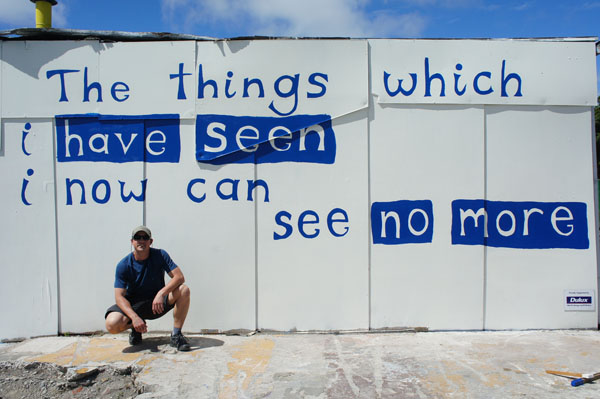Itineraries with Purpose: Serving in Natural Disaster Areas
Wise people have said that the highest levels of happiness come from giving back and helping others. This inspired me to add a service component to my world adventure. Not just another trip, not just a long vacation, but more worth, more substance.
I decided I wanted to focus on areas that have been affected by natural disasters, with a few in particular in mind: New Zealand, Japan and Chile. My goal is to serve in at least six regions over my 11-month adventure.
So far, I have served in Christchurch, New Zealand, and Ishinomaki, Japan.
Christchurch is a city where there used to be a city (as someone there put it), having suffered major damage from the 7.1 and 6.3 magnitude earthquakes that rocked the area on September 4, 2010 and February 22, 2011, respectively.
There I got hooked up with a local organization called Gap Filler, which “aims to temporarily activate vacant sites within Christchurch with creative projects, to make for a more interesting, dynamic and vibrant city.” They do all sorts of different projects, from a temporary movie theater operated by stationary bicycles, to artwork, to music venues. Instead of a vacant lot, there is something there.

The first project I worked on was simple but clever: a life-sized chess board that anyone can stop in and play at their leisure. Most everything was already there, we simply had to remove heaps of recycled glass (broken down and used for filler, like sand) and replace it with gravel (the glass had unfortunately been cutting a few people).
I also spent a couple days helping the staff build and set up the new Gap Filler headquarters, painting a mural and installing solar panels.
Considering the state of the city, a few days’ work felt pretty insignificant, but this outfit now has over a dozen gaps filled throughout the city. And with so many vacant lots, it’s nice to lay eyes on something beautiful, useful or peaceful instead of weeds and rubble.
In the northern hemisphere, Japan was devastated by an earthquake and tsunami on March 11, 2011. This was not one town or city. Miles of coastline were affected, from small fishing villages to moderately large cities, ports and harbors. Many of these towns were at or slightly below sea level, protected by seawalls sometimes 20 feet high. Most of these places now, especially the small villages, are just flat, open spaces.
I got connected with an organization based in the town of Ishinomaki, Miyagi Prefecture, a coastal area in northeast Japan that was hit particularly hard. It’s Not Just Mud (INJM) started with one person who went up to Ishinomaki after the tsunami to help in the recovery effort. As he started blogging about his experiences, others began to join him, and the group expanded over time to become an official volunteer non-profit organization.
INJM started with helping people clean up and restore their homes – those that were still standing – that were damaged by the tsunami. In these cases the homes were typically filled with up to 12 inches of mud and muck. INJM would go into a house, remove the debris, walls, floor boards, and completely gut it out, scoop and shovel out all the muck, and slowly rebuild the house. The name of the group alludes to the people who they work with and the lives that have been changed – that it’s really more than just mud. During my first days working with INJM, we finished such a house.
Another day, our team cleaned up trash and debris, separating glass, metal, and other materials. There was no telling what we would find: roof shingles, glassware, silverware, CDs, appliances, clothes, and anything else you can imagine. Picture a giant wave pulverizing your house, crushing everything in a giant washing machine filled with houses and mud, then draining the water out as everything sinks into the earth.

Reflecting on these experiences so far I’ve discovered a few things.
First, the most overwhelmingly positive part of these experiences so far has been the people who I’ve met while volunteering. I connected with people on both projects who I expect to remain friends with for years to come. In fact, of the people I met, I’ve already stayed with two of them while traveling and met another in his home country, two months later.
As great as the connections have been, finding service opportunities in foreign countries has been challenging. You’d think it would be easy; at least I did. There was a major disaster, there is limitless work to be done, there should be plenty of places to get involved, right? Not so much.
There were a few things I found helpful in searching. First, local universities are often home to volunteer student groups, which can be a good place to start. Community centers can usually point you in the right direction as well. There are also several service/outreach organizations that coordinate international volunteer efforts, including All Hands Volunteers, Go Abroad.com, Ecoteer, and ReliefWeb.
I feel fortunate to have had these opportunities. It hasn’t been earth-shattering so far – especially considering both locations, where people have been there for a year or longer in the trenches and I’ve only been able to help the effort for a few days – but it’s been great nonetheless. If you’re planning your trip, consider adding some service; you might get more out of it than you expect.
Chris Healy graduated from Fresno State University and spent nearly seven years working for the Sigma Nu Fraternity national headquarters office, traveling extensively throughout the United States for business and leisure. He left in January to embark on an 11-month, 5-continent, 25+ country adventure around the world, focusing on growth, connection, service and fitness. You can read more about Chris’ adventures at www.followchris.me.






